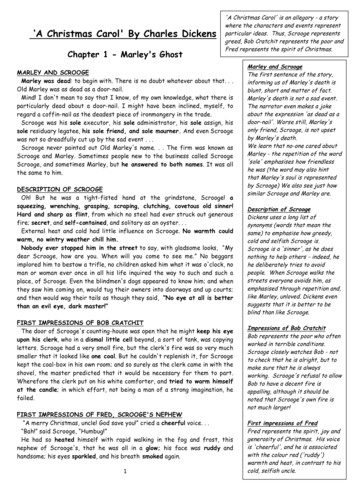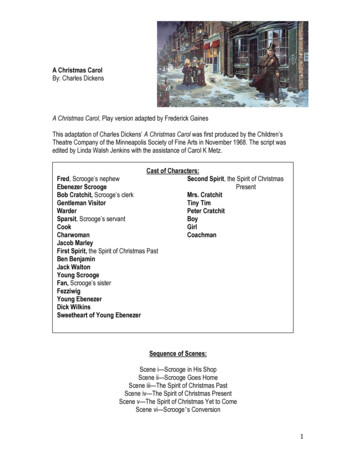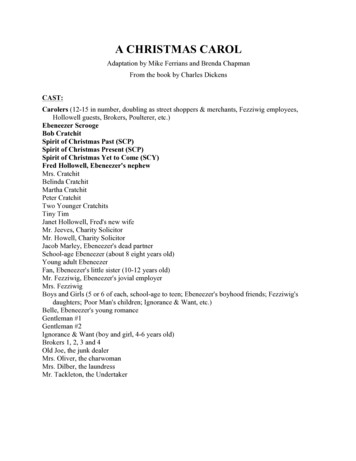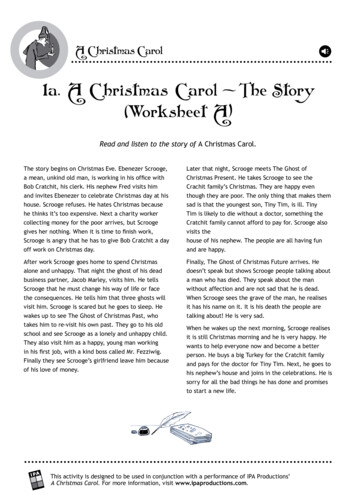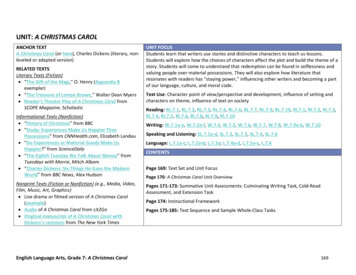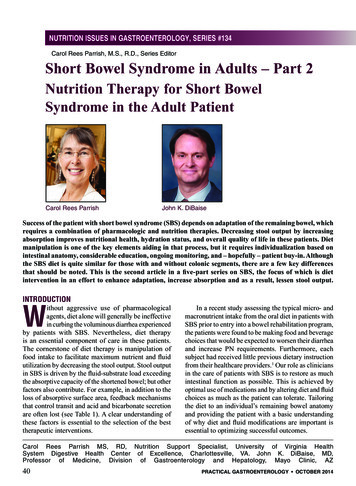
Transcription
NUTRITION ISSUES IN GASTROENTEROLOGY, SERIES #134Carol Rees Parrish, M.S., R.D., Series EditorShort Bowel Syndrome in Adults – Part 2Nutrition Therapy for Short BowelSyndrome in the Adult PatientCarol Rees ParrishJohn K. DiBaiseSuccess of the patient with short bowel syndrome (SBS) depends on adaptation of the remaining bowel, whichrequires a combination of pharmacologic and nutrition therapies. Decreasing stool output by increasingabsorption improves nutritional health, hydration status, and overall quality of life in these patients. Dietmanipulation is one of the key elements aiding in that process, but it requires individualization based onintestinal anatomy, considerable education, ongoing monitoring, and – hopefully – patient buy-in. Althoughthe SBS diet is quite similar for those with and without colonic segments, there are a few key differencesthat should be noted. This is the second article in a five-part series on SBS, the focus of which is dietintervention in an effort to enhance adaptation, increase absorption and as a result, lessen stool output.INTRODUCTIONWithout aggressive use of pharmacologicalagents, diet alone will generally be ineffectivein curbing the voluminous diarrhea experiencedby patients with SBS. Nevertheless, diet therapyis an essential component of care in these patients.The cornerstone of diet therapy is manipulation offood intake to facilitate maximum nutrient and fluidutilization by decreasing the stool output. Stool outputin SBS is driven by the fluid-substrate load exceedingthe absorptive capacity of the shortened bowel; but otherfactors also contribute. For example, in addition to theloss of absorptive surface area, feedback mechanismsthat control transit and acid and bicarbonate secretionare often lost (see Table 1). A clear understanding ofthese factors is essential to the selection of the besttherapeutic interventions.In a recent study assessing the typical micro- andmacronutrient intake from the oral diet in patients withSBS prior to entry into a bowel rehabilitation program,the patients were found to be making food and beveragechoices that would be expected to worsen their diarrheaand increase PN requirements. Furthermore, eachsubject had received little previous dietary instructionfrom their healthcare providers.1 Our role as cliniciansin the care of patients with SBS is to restore as muchintestinal function as possible. This is achieved byoptimal use of medications and by altering diet and fluidchoices as much as the patient can tolerate. Tailoringthe diet to an individual’s remaining bowel anatomyand providing the patient with a basic understandingof why diet and fluid modifications are important isessential to optimizing successful outcomes.Carol Rees Parrish MS, RD, Nutrition Support Specialist, University of Virginia HealthSystem Digestive Health Center of Excellence, Charlottesville, VA. John K. DiBaise, MD,Professor of Medicine, Division of Gastroenterology and Hepatology, Mayo Clinic, AZ40PRACTICAL GASTROENTEROLOGY OCTOBER 2014
Short Bowel Syndrome in Adults – Part 2NUTRITION ISSUES IN GASTROENTEROLOGY, SERIES #134Table 1. Factors that May Contribute to Malabsorptionin the Patient with SBS Loss of absorptive surface area Dumping into the upper gut Accelerated intestinal transito Mismatch of nutrients andpancreatico-biliary secretions Gastric hypersecretion (up to 6 months or so)o Increased volume of gastricsecretions entering the upper guto Lower pH than is normal Denatured pancreatic enzymes Destabilized bile salts Reduction in bile salt poolo Diminished micelle formation Small bowel bacterial overgrowthNutritional Assessment – Getting StartedThe initial evaluation of all SBS patients should includea comprehensive nutritional assessment. Informationobtained should include a history pertinent to weightchange, medication usage (including supplementsand over-the-counter medications), presence of GIand other symptoms that may affect oral intake orfluid loss, potential signs/symptoms of micronutrientdeficiencies, and physical assessment for signs ofdehydration and malnutrition. Additional informationthat should be collected at baseline includes pertinentpast medical, psychiatric, and surgical history,including comorbidities and the presence of bowelcomplications such as anastomotic strictures; chronicobstructions; enterocutaneous fistulae; and peritonealdrains. A nutrition support history should also beobtained, including information regarding the enteraland/or central venous access device, formula used,route and method of administration, and knownprior complications. Finally, given the high level ofmotivation required to adhere to the dietary, fluid andmedical treatments prescribed, it is useful to inquireabout their education, motivation, support system andpotential economic or other barriers.PRACTICAL GASTROENTEROLOGY OCTOBER 2014 Patients with SBS should be instructed on themeasurement of daily fluid intake and urine/stooloutput, as periodic assessment of these parametershelps guide fluid needs. It is also useful to review afood diary, preferably over a period of a few days, todetermine the SBS patient’s usual oral diet and dailyenergy intake. A baseline assessment of electrolytesand micronutrient levels (see micronutrient sectionbelow) should be obtained at the initial clinic visit.Given the high risk of metabolic bone disease in thesepatients, a bone density should be assessed at baselineand monitored every 1-2 years.Oral Diet – Lessons LearnedOriginal evidence supporting the beneficial effects ofdiet therapy in patients with SBS is based on a limitednumber of studies that have included a small numberof patients with various bowel anatomies.2-9 Thesestudies have generally demonstrated a decrease instool output and an increase in absorption dependingon the remaining bowel anatomy and the type andamount of carbohydrate and fat used. Specifically,those SBS patients with a colon segment remainingappear to derive the most benefit in terms of nutrientabsorption and reduction in stool losses from a highcomplex carbohydrate, low-moderate fat diet. In aninpatient setting, Byrne et al. followed close to 400patients over a 10 year period after providing intensivecounseling and close monitoring for 2-4 weeks andfurther demonstrated the importance of the SBS dieton improving stool output and both nutritional andhydration status.10 They concluded that patients withcolon benefited from a different diet than those withoutcolon.Luminal nutrients enhance post-resectionintestinal adaptation by increasing splanchnic bloodflow, stimulating pancreatico-biliary secretions,gut neuronal activity, and peristalsis. They also upregulate selective nutrient transporters and digestiveenzymes and stimulate local production and release ofintestine-specific growth factors.11 Importantly, nutrientcomplexity (i.e., whole foods) is associated with greaterintestinal adaptation, presumably due to recruitmentof greater digestive activity, the effects of which mayultimately decrease the need for parenteral nutrition(PN) support in SBS.Patients with an end jejunostomy typically absorbmore nutrients than fluid, so intravenous (IV) fluidsmay be required at least initially. In contrast, in those41
Short Bowel Syndrome in Adults – Part 2NUTRITION ISSUES IN GASTROENTEROLOGY, SERIES #134SBS patients with a jejuno-ileocolonic or jejunocolonic anastomosis, sodium and water are absorbedmore avidly, and these patients may require moresupplemental nutrients than fluids. For all patientswith SBS, the most important dietary interventionsinvolve smaller, more frequent feedings, avoidance ofsimple sugars in any form and chewing foods extremelywell. The long-term success of an optimized SBSdiet requires intensive education, adequate nutritioncounseling and monitoring to maintain complianceand achieve intestinal rehabilitation, PN independence,and enteral autonomy. One of the crucial roles of thedietitian is to translate all of the data into foods andmeal plans that meet the individual’s preferences andlifestyle. The patient needs to be informed not onlyof what they need to avoid, but more importantly,what they can eat. In general, most stable adult SBSpatients absorb only about one-half to two-thirds asmuch energy as normal; thus, dietary intake must beincreased by at least 50% from their estimated needs(i.e., “hyperphagic” diet).12,13 However, in some, thisincreased intake may contribute to excessive loss ofmicronutrients and fluids by worsening diarrhea.7 Theestablishment of daily calorie and fluid intake goalsis achieved by careful monitoring. Adjustments maybe needed based on tolerance, which is determined bysymptoms, stool output, ongoing assessment of whatthey eat, and in so doing, assessment of the patientsunderstanding of diet therapy, along with micronutrientlevels, weight changes, and hydration status.For some patients, instead of advising how manycalories to eat per day, a more practical approach maybe preferred. This entails a review of their normal intakefollowed by suggestions on where they can add actualfoods, such as a half sandwich, a package of “Nabs,”or a teaspoon of olive oil. Reevaluating the plan andadjusting as the patient’s needs change, particularlyduring the adaptation period, is essential for the ongoingsuccess of the SBS diet.Diet SpecificsFatFat is an excellent calorie source, yet depending uponthe remaining bowel anatomy in a SBS patient, toomuch fat may exacerbate steatorrhea, resulting in lossof calories, fat-soluble vitamins and divalent mineralsin the stool.4,7,14 Medium chain triglycerides (MCT)are often recommended for use in patients with SBS42 as they are absorbed directly across the small boweland colonic mucosa; however, it has been shown thatonly those with a remaining colon segment seem tobenefit from their use.15 Furthermore, MCT containfewer calories than dietary fat, are devoid of essentialfatty acids, are not very palatable, and do not enhanceintestinal adaptation.ProteinProtein requirements will vary depending on where thepatient is in the disease course. Protein of high biologicalvalue is always preferred over plant protein. Becausenitrogen absorption is least affected by the decreasedabsorptive surface in SBS patients, no change in dietaryprotein is generally necessary and the use of peptidebased diets in these patients is unnecessary.4,8,16,17 Oralglutamine is often recommended to patients with SBS;however, its clinical benefit is controversial and thereis insufficient data to support its use in patients withSBS.18 Glutamine is also abundant and readily availablein whole protein foods of high biological value such asmeat, fish, poultry, eggs, and dairy.CarbohydrateThe use of more complex carbohydrates as opposedto concentrated sweets reduces stool volume andenhances absorption in SBS.10 Lower fiber, complexcarbohydrates are more readily digested and absorbedand should be a primary calorie/nutrient sourceirrespective of remaining bowel anatomy. Patients witha colon segment remaining may benefit from highersoluble fiber content, but not at the expense of reducedoral intake due to early satiety, particularly if weightgain is needed.An emerging area of interest within thecarbohydrate/starch group are the fermentable, oligo-,di-, mono-saccharides and polyols, or “FODMAPs.”FODMAPs are poorly absorbed, highly osmotic, andfermentable by gut bacteria. They are found in plantfoods and liquid medications (e.g., sugar alcohols suchas sorbitol and xylitol), as well as some enteral formulas(e.g., fructooligosaccharides, or “FOS”) and areassociated with gas, bloating, cramping, and increasedstool losses.19-21 A modified FODMAP restriction (seeTable 3) may be worthwhile in the patient who is failingroutine SBS diet therapy, although further study of thisapproach is needed.(continued on page 44)PRACTICAL GASTROENTEROLOGY OCTOBER 2014
Short Bowel Syndrome in Adults – Part 2NUTRITION ISSUES IN GASTROENTEROLOGY, SERIES #134(continued from page 42)LactoseWhile often restricted by clinicians in SBS, lactosehas been shown to be tolerated by many SBS patients.Given the potential benefits of dairy foods, and becausethe symptoms of lactose intolerance are often dosedependent, many people are able to tolerate at leastsome dairy products, especially if spread over thecourse of the day. In one report, patients with SBSwere able to tolerate up to 20 grams of lactose per day(with no more than 4 grams from milk).22,23 Of note,lactose is a FODMAP (see above) and, therefore, highlyfermentable. Should a patient not tolerate lactose, it maynot necessarily be due to lactase insufficiency.Table 2. Laboratory Assessment of Possible SodiumDepletion in the SBS PatientPersistent ileostomy/jejunostomy 24 hour urinevolume 1200 mL (reflecting potential forincreased sodium losses)Urine sodium 10 - 20 mmol/LElevated plasma reninElevated plasma aldosteroneBUN:creatinine ratio 20 (late indicator, andonly after the patient is quite volume depleted)FiberPatients with jejunostomies or ileostomies are commonlyadvised to add bulk-forming agents to their diet in aneffort to thicken stool or ostomy output. While it mayseem to improve the consistency of the stool, fiber canalso result in the net loss of fluid from the bowel, asit not only pulls fluid from the mucosa, it also ‘soaksup’ fluid within the lumen, making it unavailable forabsorption. Rather than thicken the fluid in the stoolbefore it is lost to the patient’s stomal appliance, itwould be better to try to enhance absorption of thatfluid.24 Moreover, fiber may reduce the absorption ofnutrients and, in those who are already having difficultyingesting sufficient calories, the addition of bulkingagents may further exacerbate the problem by leadingto early satiety.Despite the above, a trial of soluble fiber mayoccasionally be worthwhile in an attempt to slow gastricemptying and overall transit time in the SBS patientwith rapid gastric and small bowel transit. Sourcesof soluble fiber include oatmeal, oat cereal, oat bran,lentils, apples, oranges, pears, strawberries, blueberries,nuts, legumes, ground flaxseeds, chia seeds, carrots,psyllium, guar gum, pectin, and rinds (especially drycitrus zest). These should be added slowly to give thepatients GI tract time to adapt.SBS patients with a colonic segment remainingcan generate an additional 500-1000 calories per dayfrom the absorption and utilization of short chain fattyacids that are produced by the bacterial fermentationof fiber and malabsorbed carbohydrates. Thus, the useof a moderate fat, higher complex carbohydrate dietcontaining fiber is recommended for the SBS patient44 with an intact colon.6,10,25 Since it is more fermentable,soluble fiber is preferred over insoluble fiber.OxalateOxalate is a chemical compound found in many foods.After ingestion, oxalate generally binds to calciumwithin the bowel and is excreted. In patients with fatmalabsorption, calcium preferentially binds to fat in thesmall bowel instead of oxalate. This leaves the oxalatefreely available to be absorbed, but only in patients whohave a portion of remaining colon, since oxalate can onlybe absorbed in the large intestine. After its absorption,oxalate is delivered to the kidneys for excretion (seePart I of this series). Maintaining adequate hydrationand urine output is key to prevention of oxalate stones,and in some patients, dietary avoidance of high oxalatefoods such as beets, spinach, rhubarb, strawberries,nuts, chocolate, tea, wheat bran, and all fresh, canned,or cooked dry beans (excluding Lima and green beans)is recommended.SaltPatients with SBS are at significant risk of sodiumdepletion. Normal stool sodium is approximately 4.8mEq (110 mg) per day. In those SBS patients witha jejunostomy or ileostomy, daily losses can be ashigh as 105 mEq (2430 mg) per liter of stool. Whenpersistent, sodium and fluid depletion may be associatedwith weight loss, failure to thrive, and impaired renalfunction.25-27 Signs and symptoms of sodium depletioninclude low urine output, considerable thirst and fatigue.What makes sodium depletion difficult to appreciatePRACTICAL GASTROENTEROLOGY OCTOBER 2014
Short Bowel Syndrome in Adults – Part 2NUTRITION ISSUES IN GASTROENTEROLOGY, SERIES #134Table 3. Summary Diet Recommendations for SBS Patients with and without Remaining ColonDiet ComponentEnd Jejunostomy/IleostomyColon Segment in ContinuityMeals/snacks 5-6 smaller meals/snacks per day Chew foods really well! 5 smaller meals/snacks per day Chew foods really well!Carbohydrates 50% complex CHO/avoid simplesugars including: 50% complex CHO/avoid simplesugars including:o Modified FODMAP restriction(fructose, high fructose corn syrup,sugar alcohols such as sorbitol)o Lactose – limit if necessaryo Modified FODMAP restriction(fructose, high fructose corn syrup,sugar alcohols such as sorbitol)o Lactose – limit if necessaryFat 30-40%; encourage fat with highessential fatty acid content Some MCT is ok 30% fat; encourage fat with highessential fatty acid content Some MCT is okProtein20-30%; high biological value20-30%; high biological valueFiberUsual intake—limit if too highEncourage soluble; 5 to 10 g/day(see fiber section)OxalateNo restrictionLimit, but first ensure adequate urineoutput of 1 liter dailySaltIncrease intake by salting foods, or usinghigh sodium food choicesUsual intakeFluidsORS/high sodium fluids, total fluidrestriction may be necessary in some(& IV fluids given)ORS may be necessary in some; totalfluid restriction may be necessary insome (& IV fluids given)in these patients is that creatinine levels may notaccurately reflect renal function due to the low leanbody mass many of these patients exhibit. Furthermore,serum sodium levels are usually maintained within thenormal range by renin- and aldosterone-mediated renalconservation of sodium, as well as the contraction ofthe extracellular fluid compartment, misleading theclinician.28,29 In patients with fatigue, overall failure tothrive and high stool output, an assessment of sodiumstatus is advised (see Table 2).In the patient with SBS, salty snacks are encouragedand liberal use of the salt shaker can help replace sodiumlost in the stool. Salt tablets have been used, but cancause vomiting in some; in those on enteral nutritionPRACTICAL GASTROENTEROLOGY OCTOBER 2014 support, salt can be added to the formula.5 Of course,ensure that SBS patients are not restricting salt due tocomorbid conditions they had prior to developing SBS.See Table 3 and 4 for summary diet guidelines and asample menu plan.Vitamins/Minerals: What Makes SensePatients with SBS are at risk for multiple vitamin andmineral deficiencies and as such, lifelong monitoringand supplementation is needed. We recommend abaseline assessment of electrolytes and micronutrientlevels (e.g., vitamins A, D, E, B12, folate, zinc, selenium,iron indices including ferritin, and essential fatty acids)should be obtained at the initial clinic visit. However,45
Short Bowel Syndrome in Adults – Part 2NUTRITION ISSUES IN GASTROENTEROLOGY, SERIES #134Table 4. Sample 2200 Calorie Meal PlanPatients WITHOUTColonPatients WITHSome ColonBreakfast2 scrambled eggs1 English muffin or2 slices toast6 oz lactose-freenonfat milk*(if allowed)1 tablespoonmargarine1 teaspoon diet jelly(use sparingly)4 oz coffee(if allowed)Breakfast1 cup oatmeal2 scrambled eggs1 English muffin or2 slices toast6 oz lactose-freenonfat milk*(if allowed)1 teaspoon diet jelly(use sparingly)4 oz coffee(if allowed)Morning Snack1 slice bread2 tablespoons peanutbutter½ bananaMorning Snack1 slice bread1 tablespoon peanutbutter1 bananaLunch4 oz turkey breast1 hoagie roll2 teaspoonsmayonnaise2 oz cheese2 slices tomatoLunch4 oz turkey breast1 hoagie roll1 oz cheese2 slices tomatoAfternoon Snack6 crackers2 oz cheddar cheeseAfternoon Snack12 crackers2 oz cheddar cheese2 oz deli hamDinner4 oz grilled salmon1 large baked sweetpotato1 tablespoon butterDinner4 oz grilled salmon1 large baked sweetpotato1 small dinner roll1 teaspoon butterEvening Snack8 animal crackersEvening Snack16 animal crackersNote: B everage choices and amount shouldbe individualized for each patient.46 those micronutrients whose serum values are influencedby inflammatory states or infection (e.g., vitamin A,possibly D, zinc, and ferritin) should not be checked untilthose problems are corrected. There are no evidencebased guidelines directing which micronutrients tomonitor or the optimal timing of how often to monitorthem. As a consequence, the frequency of monitoringwill generally depend upon the presence of existingor prior deficiencies. In the stable SBS patient on oroff PN, a semi-annual assessment of micronutrientsand essential fatty acids is advised. Because watersoluble vitamins are absorbed in the proximal smallbowel, deficiencies in SBS patients are uncommon. Incontrast, fat-soluble vitamin and essential fatty aciddeficiencies are more commonly encountered and mayrequire large doses to maintain normal plasma levels.When deficiency is identified, supplementation withaqueous preparations of vitamins A, D, and E in dosesthat normalize the plasma level is recommended.Supplemental zinc, and occasionally copperand selenium, may be required in the presence ofexcessive stool losses. Supplementation is oftenbased on clinical suspicion as many factors alterserum levels. Iron supplementation is not commonlyneeded, as iron is absorbed in the upper gastrointestinaltract, an uncommon site of resection in SBS patients.Supplemental iron may be needed if oral intake of ironis inadequate or when chronic gastrointestinal bleedingis present.Food-bound vitamin B12 absorption will beimpaired in those with more than 50 to 60 cm of terminalileum removed.30 These patients will require lifetimeadministration of supplemental vitamin B12. This isusually administered by injection on a monthly basis,however, synthetic oral B12 may be a preferred optionin some. If oral is used, 1000 mcg/day is recommendedand should be monitored the first 3, 6 and 12 monthsafter initiating to ensure efficacy.31 In those plagued withsmall bowel bacterial overgrowth, a methylmalonicacid should be checked in addition to serum B12, asbacterial overgrowth not only vies with the host foringested B12, but the B12 can be partially metabolizedto inactive analogues that compete with B12 for bindingand absorption.32,33Although many recommendations for micronutrientsupplementation appear in the medical literature, verylittle evidence exists to guide the clinician. Hence,practitioners are left with logic and common sense(continued on page 48)PRACTICAL GASTROENTEROLOGY OCTOBER 2014
Short Bowel Syndrome in Adults – Part 2NUTRITION ISSUES IN GASTROENTEROLOGY, SERIES #134(continued from page 46)when determining their approach. Until better evidenceis available, encourage patients to first eat nutritiousfoods, then add a therapeutic multivitamin and mineralsupplement, perhaps twice daily. A chewable, crushed,or liquid form may improve its bioavailability. Multipleindividual vitamin and mineral supplements shouldbe avoided whenever possible. One has to considernot only the osmotic effects these agents can have onstool output, but also the fluid needed to take them, notto mention the sheer cost of all of these supplementsand the time in one’s day to take them all. For thesereasons, we recommend periodically doing a “total pillcount” and then asking, “is this reasonable, and doesthe patient have time for a life too?”Special ConsiderationVitamin DPatients with SBS requiring PN are at particularly highrisk of vitamin D deficiency. Many factors contributeincluding inadequate sunlight exposure due to chronicillness; intake or tolerance to vitamin D-rich foodsmay be poor; dietary vitamin D may be malabsorbed;co-morbidities and medications may interfere withvitamin D metabolism; and, poor vitamin D status priorto developing SBS.34 Furthermore, sustaining vitamin Dis very difficult in many patients with SBS, in part dueto the fact that PN solutions only contain 200 IU perday as part of the multivitamin preparation available.Serum vitamin D (as 25-OH vitamin D) and intact PTHwith a baseline bone density scan should be done onall patients with SBS.Vitamin D is one of the few individual supplementsSBS patients may need in addition to a multiple vitamin/mineral supplement. Many practitioners use 50,000IU per week; however, some patients may do betterwith daily dosing if weekly dosing does not achieveefficacy.35 Finally, liquid vitamin D may work whennothing else will; however, some insurance companiesmay need justification that other forms were noteffective. Finally, direct sunlight to arms and legs,36or controlled UV exposure with a Sperti lamp (D/UV Lamp--www.vitaminduv.com) may work in somerecalcitrant patients.Enteral Nutrition Support – When to ConsiderThere are few published reports of the use of homeenteral nutrition (EN) support in SBS. In one recentreport from a large home EN program in Canada, only 948 of 727 patients received home EN for SBS.36 Despite itsapparent paucity of use in adults with SBS, in the SBSpatient who cannot meet their nutrition and/or fluid needsorally, a trial of EN should be considered in an attempt toprevent the need of a central venous catheter and eitherPN or IV fluid support. This intervention may be mostsuccessful in those with some remaining colon, whileits use in patients with an end jejunostomy may result inincreased ostomy output that interferes with sleep andfurther impaired quality of life. If EN is pursued, werecommend a trial of nasogastric administration beforeconsidering more permanent percutaneous access. Inthe diet- and medication-optimized patient, it will bequite apparent early on if this plan will be successfulbased on change in stool losses. Administration of theformula into the stomach via continuous infusion isrecommended in order to slow nutrient delivery in orderto maximize nutrient:mucosal contact time, hence,optimizing absorption while limiting diarrhea.38-43Overnight infusion takes advantage of utilizing theGI tract when there is nothing else to compete withmucosal receptors for absorption; plus, it does notinterfere with daytime activities. The use of a lowerosmolality, standard polymeric formula that contains amixture of LCT and MCT maintains mucosal structureand function and enhances bowel adaption; the additionof fiber as part of the enteral product or as a solublefiber supplement is recommended in those patients withsome colon remaining. In addition to not being superiorto standard polymeric products, the hyperosmolarnature of elemental products may actually increasestool output. Finally, as there is no suitable bile saltsupplement readily available, those patients with bilesalt deficiency will benefit from a lower fat formula.44Parenteral NutritionVirtually all patients with SBS require parenteralnutrition (PN) support in the initial period followingresection, and most will require PN at home after theirdischarge from the hospital. PN caloric requirementswill depend on many factors such as need to gain (orlose) weight, ambulation/activity level, etc. and no oneprescription fits all. PN should be initiated and adjustedto meet the patient’s fluid, electrolyte, energy, protein,and micronutrient needs. Overall energy content andmacronutrient composition will depend to some degreeupon the SBS patient’s oral intake and the level ofrepletion required. In situations of high ostomy output,(continued on page 50)PRACTICAL GASTROENTEROLOGY OCTOBER 2014
Short Bowel Syndrome in Adults – Part 2NUTRITION ISSUES IN GASTROENTEROLOGY, SERIES #134(continued from page 48)increased fluid, potassium, magnesium, and zinclosses occur and need to be monitored and replacedappropriately. The amount of PN can be decreasedwhen the patient demonstrates ability to take oralnutrition without excessive stool or ostomy output withappropriate weight maintenance or gain. In calculatingPN volume and content, changes in the patient’sweight, labs, stool or ostomy output, urine output,and complaints of thirst should be considered. Thesepatients remain at risk for micronutrient deficienciesand require periodic monitoring and supplementationin addition to PN.45Home PN is usually infused over 10 to 14 hoursovernight in order to allow the patient freedom from theinfusion pump during the day and potentially to reducethe risk of liver injury with long-term use. In somepatients, the volume needed may cause high volumenocturnal urination. These patients may do better withless volume at night, and one or two liters of “chaser”IV fluids during the morning or evening before theyhook up their PN for the night. Programmable infusionpumps are used by most consumers. Portable pumps thatcan be carried in a backpack or tote are also availablefor the PN consumer who needs to infuse during theday. Patient support groups such as the Oley Foundation(www.oley.org) are important sources of informationon practical topics (e.g., body image, travel), education,and support and may reduce the risk of complications,enhance survival, and the quality of life of the patientreceiving either EN or PN support.CONCLUSIONNutrition therapy is central to the successfulmanagement of the patient with SBS. Substantial andongoing education at a level the patient/caregiver canunderstand from the outset is essential, and adequatetime must be allotted for this purpose. As the boweladapts and absorption improves, it is possible that dietinterventions can be liberalized. Lifelong monitoringis necessary in all SBS patients and management goalsoften change over time. See Table 5 for additional SBSrelated resources. nTable 5. Other Short Bowel Syndrome-related Resources Professional Texts/Articles Nightingale JM (Ed). Intestinal failure. Greenwich Medical Media Limited. London, England 2001. P arrish CR. The Clinician’s Guide to Short Bowel Syndrome. Practical
helps guide fluid needs. It is also useful to review a food diary, preferably over a period of a few days, to determine the SBS patient’s usual oral diet and daily energy intake. A baseline assessment of electrolytes and micronutrient levels (see micronutrient section below) should






